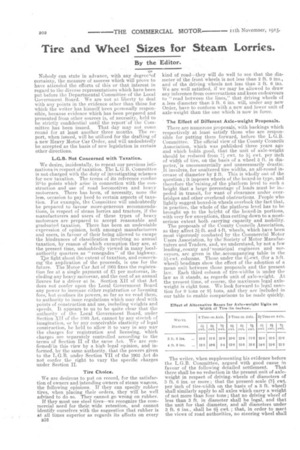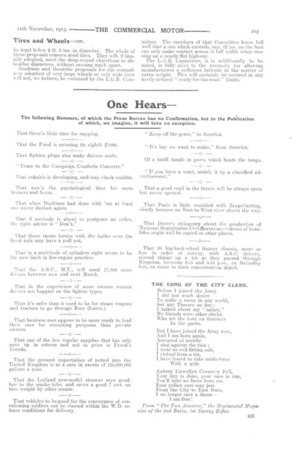Tire and Wheel Sizes for Steam Lorries.
Page 2

Page 3

If you've noticed an error in this article please click here to report it so we can fix it.
By the Editor.
Nobody can state in advance, with any deg,reeof certainty, the measure of success which will prove to have attended the efforts of this or that interest in regard to the diverse representations which have been put before the Departmental Committee of the Local Government Board. We are not at liberty to deal with any points in the evidence other than those for which the writer has himself been personally responsible, because evidence which has been prepared and presented from other sources is, of necessity, held to be strictly confidential until the report' of the Committee has been issued. That day may not .come round for at least another three months. The report, when issued, will be utilized for the drafting of a new Heavy Motor Car Order, and will undoubtedly be accepted as the basis of new legislation in certain other directions.
L.G.B. Not Concerned with Taxation.
We desire, incidentally, to repeat our previous intimations inrespect of taxation. The L.G.B. Committee is not charged with the duty of investigating schemes for new taxation. The terms of its reference confine it'qo points which arise in connection with the construction and use of road locomotives and heavy motorcars. There has been, of necessity, none the less, occasion to pay heed to certain aspects of taxation. For example, the Committee will undoubtedly be prepared to favour more-generous recommendations, in respect of steam lorries and tractors, if the manufacturers and users of these types of heavy motorcars are prepared to accept reasonable and graduated taxation. There has been an undeniable expression of opinion, both amongst manufacturers and users, in favour of their being allowed to escape the hindrances of classification involving no annual taxation, by reason of which exemption they are, at the present time, undoubtedly viewed in many localauthority quarters as " renegades" of the highway. The fight about the extent of taxation, and concerning'Ithe anPlication of the proceeds, is one for the future. The Motor Car Act of 1903 fixes the registration fee at a single payment of R1 per motorcar, including any heavy motorcar, and the cost of an annual licence for a driver at as. Section XII of that. Act does not confer upon the Local Government Board any power to increase either registration or licensing fees; but confines its powers, so far as we read them, to authority to issue regulations which may deal with points of construction and use, including weights and speeds. It appears to us to be quite clear that the authority of the Local Government Board, under Section XII of the 11303 Act, cannot by any stretch of imagination, or by any conceivable elasticity of legal construction, be held to allow it to vary in any way the charges for registration and licensing, which charges are separately controlled according to the terms of Section II of the same Act.We are eonfirrned;in this view by a high legal opinion, and informed, by the same authority, that the powers given to the L.G.B. under Section VII of the 1903 Act do not confer the right to vary the specific charges under Section II.
Tire Choice.
We are desirous to put on record, for the satisfaction of owners and intending owners of steam wagons, the following opinions. If they can specify rubber tires, when placing their orders, they will be well advised to do so. They cannot go wrong on rubber. If they must use steel tires—we recognize the commercial need for their: wide retention, and cannot identify ourselves with the suggestion that rubber is at all times superior as regards its effects on every B16 kind of road—they will do well to see that the diameter 'of the front wheels is not less than 2 ft. 9 ins., and of the driving wheels not less than 3 ft. 6 ins. We are well satisfied, if we may be allowed to draw any inference from conversations and keen endeavours to " read between the lines," that driving wheels of a.less diameter than 3 ft. 6 ins, will, under any new Order, have to conform with a new and lower unit of axle-weight than the one which is now in force.
• The Effect of Different Axle-weight Proposals.
There are numerous proposals with backings which respectively at least satisfy those who are responsible for putting them forward, before the L.G.B. Committee. The official view of the County Councils Association, which was published three years ago and which holds good, that the unit of axle-weight should be reduced from 7 cwt. to 511 cwt. per inch of width of tire, on the basis of a wheel 3 ft. in diatrieter,"is uncommercially and unnecessarily drastic. It involves, for unaltered tire widths, an all-round increase of diameter by 2 ft. This is wholly out of the question; it imposes wheels of the boxed-in type, and therefore theraising,of the platform level to such a height that a large Percentage of loads must be impeded in transit, for want of clearance under overbridges and other overhead obstructions. People who lightly suggest boxed-in wheels overlook the fact that, in practice, the whole of the platform level has to he brought up to the height of the boxed-in portions, with very few exceptions, thus cutting down to a mostserious extent loath carrying capacity and mobility. The proposals of the County Councils Association, as they affect 30t. and 4-ft. wheels, which have been most vigorously combated by the Commercial Motor Users Association, by the Society of Motor Manufactuiers and Traders, and, we understand, by not a few leading, county and municipal engineers and surveyors, are given in the accompanying table in the 5,1-cwt. columns. Those under the 6:1,-cwt. (for a 3-ft. wheel) headings show the effect of the adoption of a mean unit between those proposals and the present law. Each third column of tire-widths is under the law as it stands, as regards unit of axle-weight. At the present time, of course, the maximum legal axleweight is eight tons. We look forward to legal sanction for 9 tons or W, tons, and they are included in our table to enable comparisons to be made quickly.
The writer, when supplementing his evidence before the L.G.B. Committee, argued with good cause in favour of the following detailed settlement. That there shall be no reduction in the present unit of axleweight in respect of driving, wheels of diameters of 3 ft. 6 ins, or more ; that the present scale (71 ewt. per inch of tire-width on the basis of a 3 ft. wheel) shall similarly apply to all axles which carry a weight of not more than four tons ; that no driving wheel of less than 3 ft. in diameter shall he legal, and that the unit for that diameter, and all diameters under 3 ft. 6 ins., shall be 6i cwt. ; that, in order to meet the views of road authorities, no steering wheel shall be legal below 2 ft. 9 ins. in diameter. The whole of these proposals concern steel tires. They will, if happily adopted, meet the deep-rooted objections to the smaller diameters, without causing much upset. Academic and theoretic proposals forothe compulsory adoption of very large -wheels or yei"y wide tires will not, we believe, be endorsed by the L.O.B. Corn mittce. The members of that Committee know full well that a tire which exceeds, say, 12 ins, on the face can only make contact across it full width when running on a nearly-flat highway. The L.U.B. Committee, it is additionally to be noted, is fully alive to the necessity for allowing manufacturers a sufficient latitude in the matter of extra weight. This will certainly be covered in any newly-defined " ready-for-the-road " limits.




















